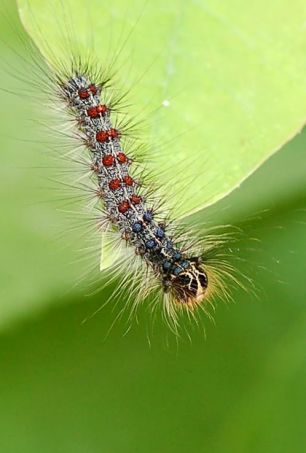
Asian gypsy moth
What is it? 
Asian gypsy moth (Lymantria dispar) is a species of moth currently not present in Australia. It represents a serious threat to our forestry and horticultural industries. Asian gypsy moth caterpillars feed on over 600 species of plants and the moths have the ability to fly almost 65 kilometres.
What does it look like?
Asian gypsy moth larvae are very hairy and can grow to 70 mm long. Larvae vary in colour but have a distinctive double row of coloured spots along the length of the body: five pairs of blue spots followed by six pairs of red.
Eggs are deposited in egg mass clusters about 2–3 cm in size. Each egg mass may contain up to 1200 eggs. The egg masses are laid on hard surfaces, usually tree trunks or branches, but also on rocks, walls, fences etc. They are covered with yellowish or tan fuzz from the abdomen of the female.
Adult male Asian gypsy moths are grey to brown in colour with dark wavy wing patterning and a wingspan of 30–40 mm. The female Asian gypsy moth is larger than the male and appears more slender in body shape when at rest. The female is primarily white with dark wavy wing patterning and has a wingspan of around 40–70 mm.
How is it spread?
Asian gypsy moth are attracted to lights and can hitch a ride to Australia on ships and containers due to their habit of laying eggs on hard surfaces, such as ships loaded at night. Egg masses have been found on logs, outdoor furniture, nursery stock, pallets, shipping containers and on the hulls and rigging of ships.
Adults are also able to spread naturally due their ability to fly long distances. Young larvae spread on silk webbing dispersed by the wind. Larvae spin a thread of silk and suspend themselves from the threads which eventually break. The larva is then carried by the wind. While most larvae will not move more than 200 metres, some are reported to travel several kilometres.
Where is it found?
Asian gypsy moths originate from China and far eastern Russia. It has now spread through Korea, Japan and Europe.
What is the potential cost to Australia?
Asian gypsy moth have the potential to cause significant damage to a wide range of hosts and are known to complete their lifecycle on more than 600 species.
Host plants include Australian native species, forestry, orchard and ornamental trees.
They can attack valuable horticultural crops including apple, apricot, cherry, chestnut, hazelnut, lychee, plum, rose and walnut.
The NSW forestry industry is worth approximately $470 million a year and the NSW horticultural industry is worth approximately $1.79 billion a year.
How do I report it?
If you suspect Asian gypsy moth call the Exotic Plant Pest Hotline 1800 084 881 or email biosecurity@dpi.nsw.gov.au with a clear photo and your contact details.
More information
For more information visit Asian gypsy moth.

